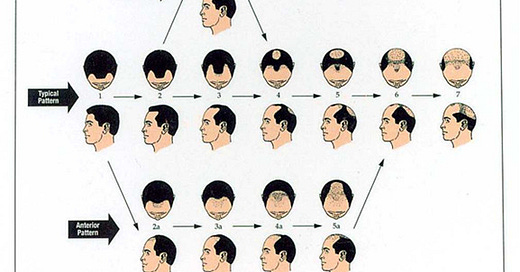Workup of Hair Loss in Men
The two most common causes: androgenic alopecia and telogen effluvium
There are numerous causes of hair loss, and this article is only going to focus on the two most common of them: androgenic alopecia and telogen effluvium.
Androgenic alopecia
In men, this is going to be the most common cause overall and is characterized by male-pattern hair loss recognized by progression along the Hamilton-Norwood scale:
Image source: https://www.ncbi.nlm.nih.gov/books/NBK278957/
Dihydrotestosterone (DHT) is the key androgen involved in this type of alopecia, which recall from my post Male Sex Hormones, Part 1, is synthesized from testosterone by the action of the enzyme 5⍺-reductase.
There are two isoforms of 5⍺-reductase which have different areas of expression:
Type 1: in liver and nongenital skin
Type 2: in liver and genital skin/genital tract
DHT is a more potent androgen than testosterone, has a higher affinity for the androgen receptor, and plays an important role in the development and maintenance of male sexual characteristics, such as the growth of body and facial hair, deepening of the voice, and development of the male genitalia during puberty, and libido. It also contributes to acne, and in excess contributes to benign prostate hypertrophy.
Androgenic alopecia is primarily caused by a genetic predisposition to higher sensitivity to DHT, and has been linked to variations in the androgen receptor gene found on the X chromosome.
As a result of higher androgen sensitivity, the there is progressive miniaturization of the hair follicle with each cycle. This minaturization results in finer and finer hair, until it is gone completely.
Image source: https://www.researchgate.net/publication/351500480_Topical_Treatment_for_Scarring_and_Non-Scarring_Alopecia_An_Overview_of_the_Current_Evidence
Management options for androgenic alopecia:
Decreasing DHT levels systemically with 5⍺-reductase inhibitors. In general,
Keep reading with a 7-day free trial
Subscribe to BowTiedLoon’s Newsletter to keep reading this post and get 7 days of free access to the full post archives.





